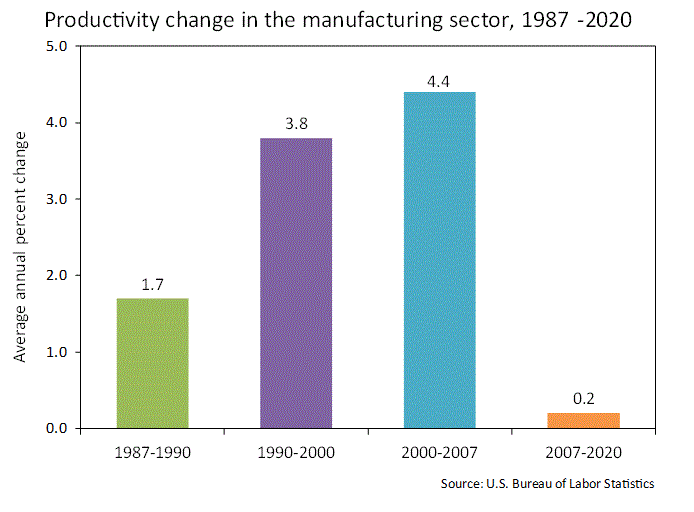The past 15 years have been economically tough for many Americans, but there are encouraging signs of a turnaround.
In their recent article, The Coming Productivity Boom, Stanford Digital Economy Lab (S-DEL) Director Erik Brynjolfsson and S-DEL Digital Fellow Georgios Petropoulos point out that while US labor productivity growth averaged only 1.3 percent since 2006—less than half the rate of the previous decade—productivity growth increased by 5.4 percent in the first quarter of 2021. “There’s reason to believe that this is not just a blip,” the researchers write, “but rather a harbinger of better times ahead: a productivity surge that will match or surpass the boom times of the 1990s.”
After growing at an average annual rate of around 2.8 percent between 1947 and 1973, US productivity has significantly slowed down, except for the internet-driven productivity boost between 1996 and 2004. Despite the relentless advances of digital technologies over the past 15 years—from smartphones and broadband wireless to cloud computing and machine learning—productivity has only grown at an anemic 1.3 percent, between 2006 and 2019. Most OECD countries have seen similar slowdowns.
What accounts for this puzzling so-called productivity paradox and when might it finally end? During the past several years, Brynjolfsson and his collaborators have explored this question, first at MIT where he was faculty director of the MIT Initiative on the Digital Economy, and since 2020 at Stanford, where he’s director of S-DEL. Brynjolfsson discussed alternative explanations for the paradox at a recent MIT conference.


Measuring productivity is difficult in an increasingly digital economy
Most measures of economic performance used by government officials to inform their policies and decisions are based on gross domestic product, or GDP. But this measurement is a relic of a time dominated by manufacturing when the production of physical goods was much easier to measure. GDP is a much less reliable measure of economic output and productivity in our digital economy, where services play a much bigger role and are subject to considerably more variation in quality and value.
How do you measure the value of the explosive amounts of free goods available over the internet, including Wikipedia articles, Facebook social interactions, Linux open-source software, and YouTube videos? Since all these services are free, they’re excluded from GDP measures. Furthermore, many new services we used to pay for are now also free or nearly so, including long-distance calls, news, maps, and music.
A 2019 research paper co-authored by Brynjolfsson introduced a novel method for measuring the value of free digital goods to consumers using online experiments. The experiments provided an estimate of the consumer surplus of a digital good, loosely defined as the difference between the amount consumers would be willing to pay and the actual price they did pay for the digital good. The data showed that the digital economy is contributing considerably more consumer value than we’ve realized, especially when you consider that 15 years ago many of these digital services didn’t exist or were in their infancy. Now, they’re tightly integrated into our work and personal lives, much more so since many of our interactions have been driven online by the pandemic.
Innovation and productivity are declining
Some economists contend—most prominently Northwestern University’s Robert Gordon—that our current digital technologies, advanced and exciting as they might be, aren’t as transformative as the industrial-age technologies from the period between 1870 and 1970 when we experienced high productivity growth and a rising standard of living. Gordon argues that the slow growth of the past few decades isn’t cyclical, but rather evidence that long-term economic growth may be grinding to a halt. There was little growth before 1800, and there might conceivably be little growth in the future.
However, even a technology skeptic like Gordon admits that the pandemic will likely have a positive impact on productivity—albeit a small one—as a result of the accelerated digitization and reorganization of work.
In July, Brynjolfsson and Gordon made a modest Long Bets wager regarding productivity growth for this decade. Brynjolfsson predicts that “private nonfarm business productivity growth will average over 1.8 percent per year from the first quarter (Q1) of 2020 to the last quarter of 2029 (Q4).” Gordon challenges that prediction, arguing that 1.8 percent productivity growth isn’t consistent with the historical record. The loser of the bet will make a $400 donation to GiveWell charities.
Tech advances rapidly, humans not so much
A third explanation for the productivity paradox—and the one I find most compelling—is described in The Productivity J-Curve, a working paper co-authored by Brynjolfsson in January 2020. According to the paper, there’s generally been a significant time lag for a major new transformative technology to be widely embraced across economies and societies. While technologies may advance rapidly, humans and our institutions change slowly.
The paper identifies two phases, investment and harvesting, in the life cycle of a historically transformative technology. Since these technologies are general purpose in nature, they require massive complementary investments for their full benefits to be realized, including new products, processes and business models, and the re-skilling of the workforce. The more transformative the technology, the longer it takes to reach the harvesting phase—and only then will it be widely embraced by companies and industries. Translating technological advances into productivity gains requires major transformations in the strategy, organization, and culture of institutions—and these take considerable time.
For example, US labor productivity grew at only 1.5 percent between 1973 and 1995. This period of slow productivity coincided with the rapid growth in the use of IT in business, giving rise to the Solow productivity paradox, a reference to Nobel Prize MIT economist Robert Solow’s 1987 quip: “You can see the computer age everywhere but in the productivity statistics.” But starting in the mid-1990s, US labor productivity surged to over 2.5 percent, as fast-growing internet technologies and business process re-engineering helped to spread productivity-enhancing innovations across the economy.
Similarly, productivity growth didn’t increase until 40 years after the introduction of electric power in the early 1880s. It took until the 1920s for companies to figure out how to restructure their factories to take advantage of electric power with manufacturing innovations like the assembly line and new electric products like consumer appliances. And while James Watt’s steam engine ushered the Industrial Revolution in the 1780s, its impact on the British economy was imperceptible until the 1830s because their use was restricted to the few industries who could afford their high early costs.
S-DEL researchers are exploring new means and methods to measure a rapidly changing digital economy.



The rise of the productivity J-curve
Brynjolfsson argues that the 2020s will be a decade of innovation and productivity, a kind of 21st century Roaring Twenties. What accounts for his optimistic prediction? Brynjolfsson cites three reasons why “this time around the productivity J-curve will be bigger and faster than in the past.”
Reason #1: The advancement of AI and other digital technologies. Beyond AI, several scientific and technological advances are ready to transition from the investment phase of the J-Curve to the harvesting, productivity-growth phase. These include digital innovations that have been considerably accelerated by the pandemic, such as telemedicine, e-commerce, and remote work, as well as breakthrough advancements in renewable energy and biomedical sciences. “In drug discovery and development, new technologies have allowed researchers to optimize the design of new drugs and predict the 3D structures of proteins,” writes Brynjolfsson. “At the same time, breakthrough vaccine technology using messenger RNA has introduced a revolutionary approach that could lead to effective treatments for many other diseases.”
Reason #2: Exponential growth caused by the pandemic. “The recent COVID-19 relief package is likely to reduce the unemployment rate from 5.8 percent (in May 2021) to the historically low pre-covid levels in the neighborhood of 4 percent,” writes Brynjolfsson. “Low unemployment levels drive higher wages, which means firms have more incentive to harvest the potential benefits of technology to further improve productivity.”
Reason #3: Incentives created by ambitious policies. Aggressive US fiscal and monetary policies are creating greater incentives for companies to implement productivity improvements.
“When you put these three factors together—the bounty of technological advances, the compressed restructuring timetable due to COVID-19, and an economy finally running at full capacity—the ingredients are in place for a productivity boom. This will not only boost living standards directly but also frees up resources for a more ambitious policy agenda.”
In addition to being a digital fellow at the Stanford Digital Economy Lab, Irving Wladawsky-Berger is a research affiliate at MIT’s Sloan School of Management and fellow at both the MIT Initiative on the Digital Economy and MIT Connection Science initiative.
Keep reading